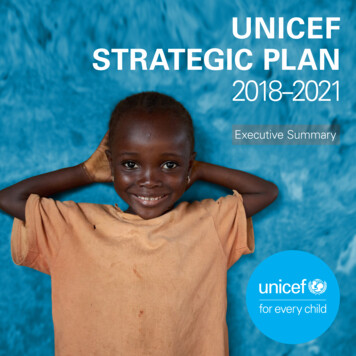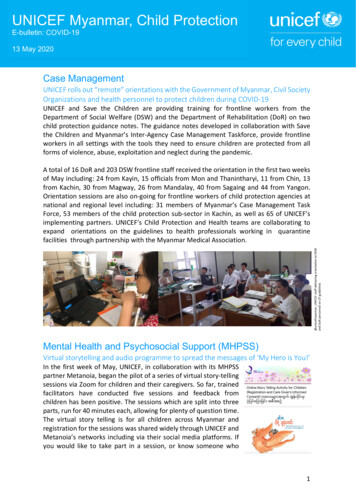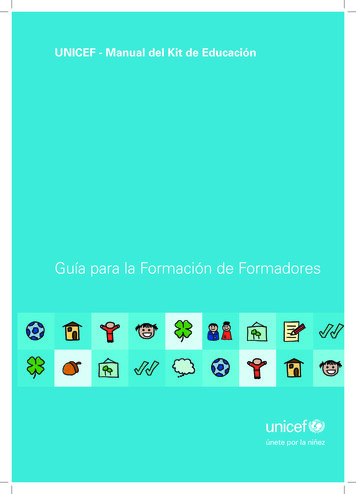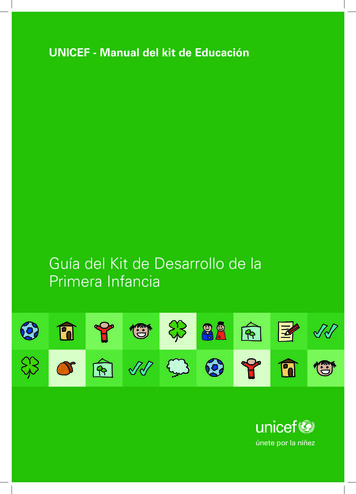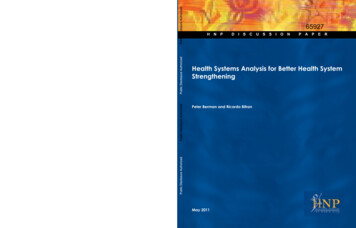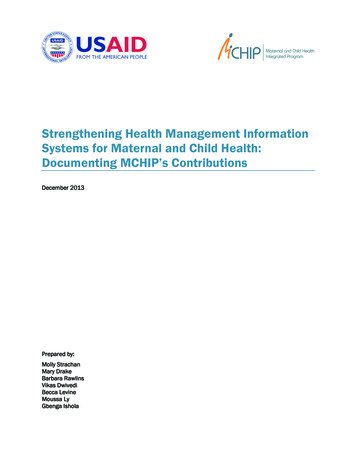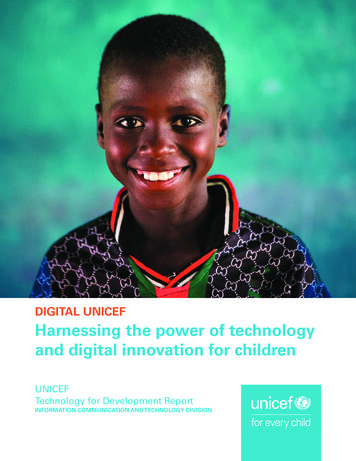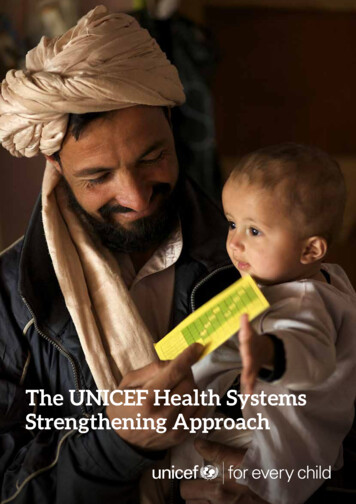
Transcription
The UNICEF Health SystemsStrengthening Approach
Health Section Programme DivisionUNICEF New YorkNovember 2016Photo credits:Cover: UNICEF/UNI100270/Noorani Page ii: UNICEF/UNI159004/Haque Page vi: UNICEF/UNI100743/AsselinPage 4: UNICEF/UN025836/Frisone Page 8: UNICEF/NYHQ2004-1418/Pirozzi Page 11: UNICEF/UNI159018/HaquePage 16: UNICEF/UNI189565/Ademuyiwa Page 18: UNICEF/UNI134947/Ose Page 19: UNICEF/UNI76604/HolmesPage 24: UNICEF/UN06204/Mackenzie Page 29: UNICEF/UNI108425/Asselin Page 30: UNICEF/UNI139075/MarkiszPage 32: UNICEF/UNI201883/Schermbrucke Page 36: UNICEF/UNI201872/Schermbrucke Page 40: UNICEF/UNI130500/SinghNesbittPage 48: UNICEF/UNI193677/Esiebo Page 56: UNICEF/UNI201879/Schermbrucke Page 63: UNICEF/UNI136059/DeanPage 64: UNICEF/UNI125796/Nesbitt Page 67: UNICEF/UNI125143/Krzysiek
The UNICEF Health SystemsStrengthening Approach
ContentsAcronyms.ivAcknowledgements.v1 Introduction.12 UNICEF’s vision and definition of, and approach to health.5systems serving children and women2.1 Vision.52.2 UNICEF’s working definition of HSS and the related context.52.3 UNICEF’s overarching approach to HSS.63 UNICEF’s areas of focus and options for action in HSS.93.1 Strengthen community-based health systems and community engagement.123.2 Strengthen sub-national management capacity for service delivery.14in the health system3.3 Develop national, equity-focused, RMNCAHN-related policies,.15strategies, planning, financing and approaches to budgeting3.4 Data and information for action, accountability and learning.203.5 Comprehensive supply system strengthening.213.6 Social protection.233.7 Private sector and CSO engagement.253.8 Quality improvement.274 Complementarity and partnership opportunities.315 Actions needed to move forward on HSS.336 Conclusion.37References.38AppendixAppendix 1 UNICEF Brief: Universal Health Coverage.41Appendix 2 UNICEF’s HSS tools at national, district and community levels, .49and overview of EQUISTAppendix 3 Suggested indicators for monitoring progress on HSS initiatives.57Appendix 4 Operational guidance on HSS for UNICEF regional and country offices.65The UNICEF Health Systems Strengthening Approachiii
AcronymsivCLTSCommunity-led total sanitationCSOCivil society organizationDHSSDistrict health system strengtheningHSSHealth systems strengtheningICCMIntegrated community case managementIRDSImplementation research and delivery scienceLMICLow and middle income countriesMDGsMillennium Development GoalsMoRESMonitoring of Results for Equity SystemNCDsNon-communicable diseasesNGONon-government organizationPHCPrimary health careRMNCAHNReproductive, maternal, newborn, child and adolescent health and nutritionSDGsSustainable Development GoalsUHCUniversal health coverageWASHWater, Sanitation and HygieneThe UNICEF Health Systems Strengthening Approach
AcknowledgementsThe document was written by David Hipgrave, Ngashi Ngongo, Gabriele Fontana, KumananRasanathan and Mickey Chopra. Development of this document was led by the Health SystemsStrengthening Unit in the Health Section, Programme Division at UNICEF New York headquarters.The content is based on a consultation held in Nairobi in May, 2015, with wide participation ofcolleagues from all Regional Offices, several Country Offices and other UNICEF Programmecolleagues. Many others from the Health Section and other UNICEF Sections and Divisionsalso contributed.The UNICEF Health Systems Strengthening Approachv
1 IntroductionSince 1990, remarkable gains have been made in improving outcomes for children and women.The number of children dying before the age of five years has almost halved,1 and similar progresshas been made in maternal mortality.2 A few easily preventable and treatable conditions areresponsible for almost 60 per cent of the remaining child deaths,3 and 75 per cent of these deathsoccur in only 20 countries.4 It has been particularly difficult to reduce child mortality during theperinatal period. Following the 2012 Washington call for a renewed commitment to child survival,a total of 178 countries have declared their intent to end preventable maternal and child deathsby 2030.1Persisting inequity in rates of child and maternal death between and within countries1 underlinesa number of challenges to further reducing preventable child and maternal mortality and ill health.Perhaps the most widespread are barriers to achieving universal coverage of life-savinginterventions and basic care.3 Recent analysis suggests that the urban-rural divide remains verywide, and that there are also disparities between and within urban areas.5, 6 Even for those withphysical access to preventive and clinical health services, poor quality and the associated direct andindirect costs limit the impact and uptake of available services, and can lead to further illness andimmiseration.1In addition to declining mortality, stunting (chronic undernutrition) among children below age fivedecreased from 40 per cent in 1990 to 25 per cent in 2013. However stunting continues to affectan estimated 161 million children globally. Moreover, wasting (acute undernutrition) affected8 per cent of children under five (51 million) in 2013; 17 million were severely wasted.7Undernutrition (including foetal growth restriction, stunting, wasting, and deficiencies of vitamin Aand zinc) and suboptimum breastfeeding are collectively responsible for 45 per cent of deaths inchildren under five.8 In 2015, this would have resulted in over 2.65 million deaths.Sustained improvement in child mortality and under-nutrition will depend on more than highimpact interventions. As dramatically highlighted by the Ebola crisis in West Africa, fragile healthsystems in many low and middle income countries (LMIC) undermine progress. The 2016 Zikaoutbreak is another example of how broader developments such as frequent travel are alsocomplicating and exacerbating the context. Changes in disease epidemiology and lifestyle areaffecting health outcomes across the life cycle,9 with some predispositions to ill health acquiredeven before conception.10 Climate change is affecting the risk of certain diseases in different partsof the world,11 and the demographic transition is affecting population distribution and creatingnew challenges. For example, in Africa, high fertility and the increasing number of fertile womenwill lead to a doubling of children there within the next 35 years, requiring massive expansion ofrelated services. At the same time, ageing populations in all nations will also require improvedhealth and social services.12 Urbanization also presents new challenges,6 and the governance ofhealth services is often weak and fragmented.13Over the 2000s there were large increases in funds for development assistance in health, but thesewere largely for disease-specific programmes in poorer nations,14 have plateaued, and arguably didnot significantly improve weak health systems in many LMIC.15 Input-level interventions havelimited impact on the efficient and effective functioning of health systems,16 which is essentialfor the future achievement of universal health coverage (UHC),13 and on the flexibility required toensure resilience to crises such as epidemics and natural disasters.17 In addition, many MIC haveactually experienced a reduction in development assistance for health, making investing in healthand health systems strengthening (HSS) in these countries even more crucial to sustaining progress.The UNICEF Health Systems Strengthening Approach1
1 IntroductionGiven this historic context and increasing attention to individual, national and global health security(broadly defined to include the establishment and maintenance of good health),18 governments,leading donors and development agencies are increasingly focusing on building robust, responsiveand resilient health systems to meet the new challenges of the 21st century.19-22 This calls for anorganization-wide, systematic realignment of UNICEF’s approach in health and related sectors,considering health and development outcomes in all programmes and contexts, and with betterlinkages between the four explicitly health-related areas of programming (Health; Nutrition;Water, Sanitation and Hygiene [WASH] and HIV) and other programmes (Child Protection,Education, and Social Inclusion and Policy).To this end, UNICEF has recently developed its “Strategy for Health: 2016-2030”, with twooverarching objectives: Ending preventable maternal, newborn and child deaths, and promotingthe health and development of all children. Three approaches are proposed: (i) addressinginequities in health outcomes; (ii) promoting integrated, multi-sectoral policies and programmes toenhance child development and address immediate causes and underlying determinants of poorhealth outcomes, and (iii) HSS, including for emergency preparedness and responsiveness, andto ensure resilience. The Strategy calls for “vertical” programmes to address critical conditions and“horizontal” programmes to explicitly strengthen systems. The Strategy also emphasizes increasingintegration of development and humanitarian efforts through risk-informed programming inall contexts.HSS requires a different approach to vertical health programmes, which have traditionally sought toimprove outcomes primarily by providing inputs. UNICEF has a long history of input-level supportfor the health sector, leading the child survival revolution in the 1980s through the expansion ofhigh-impact interventions, strengthening supply systems and training human resources. Thissucceeded most obviously for vaccine-preventable diseases and vitamin A deficiency, and morerecently for malaria through the use of treated bed-nets.3 UNICEF also supported the BamakoInitiative’s focus on local accountability and cost recovery.23 In the Millennium Development Goal(MDG) era, UNICEF supported the scaled-up provision of an expanded package of life-savinginterventions,24 accompanied by innovations in the delivery of services at community level.25, 26More recently, UNICEF has explicitly focused on equity and improving outcomes for the world’smost vulnerable children, which (for child survival) can be more cost effective.27 The Monitoringof Results for Equity System (MoRES) provides a framework for the design and monitoring of allUNICEF programmes, with an earlier28 emphasis on six core determinants of health service coverage(related to the demand for, supply and quality of healthcare29), which now also includes four“enabling environment” determinants.A, 30 For health, including the latter requires attention tobroader performance drivers such as policies, financing, regulation, organizational structures andrelationships between the health system and other sectors in order to motivate changes inbehaviour and/or allow more effective use of resources to improve health outcomes.A2Supply-side determinants: 1. Availability of essential commodities, 2. Availability of human resources, and 3. Geographical accessibility.Demand-side determinants: 1. Initial utilization by the target population, 2. Adequate and continuous utilization by the target population.Effective or quality coverage: 1. Services meeting the required norms and standards to ensure impact.Enabling environment: 1. Social norms; 2 Legislation, policies/strategies; 3. Budget/fiscal space and disbursement processes; and4. Coordination, accountability and management.The UNICEF Health Systems Strengthening Approach
1 IntroductionUNICEF is the major child-focused global development agency. It has an extensive field programmeand partnerships with governments and other development agencies at all levels, as well as policyexperts and academia. As such, UNICEF is well-placed to contribute to the technical and policydiscourse on HSS. Moreover, UNICEF’s equity-focused and rights-based approach is underwrittenby a growing portfolio of programmatic and technological innovations, particularly those focusedon strengthening public and private sector accountability for health outcomes. Adopting a clearHSS approach will help UNICEF to: a) better deal with health system issues that limit equitableoutcomes for children; b) focus on whether UNICEF support in a given country indeed strengthensits health system; c) further improve child and maternal health outcomes and ensure thesustainability of UNICEF-supported programmes; d) identify synergies with other developmentpartners and sectors in addressing critical issues; and e) coherently communicate what UNICEFdoes in health to governments and partners in the context of the post-2015 agenda and efforts toachieve UHC.The Sustainable Development Goals (SDGs) consideration of health as a foundation for social andeconomic development,21 individual and global health security, and indeed political security,18merits this shift in UNICEF’s approach from health system support to multi-sectoral HSS. Theadoption of HSS in UNICEF’s Strategy for Health, 2016-2030, also justifies this shift. UNICEF holdsHSS as imperative to its mandate on promoting all children’s rights to survival, growth anddevelopment, particularly those of the most vulnerable children in an evolving world.The UNICEF Health Systems Strengthening Approach3
2 UNICEF’s vision and definition of,and approach to health systemsserving children and women2.1 VisionUNICEF envisions health systems that reliably deliver integrated service packages for children,adolescents and reproductive age women, focusing on health, nutrition, WASH and HIV. A stronghealth system also facilitates child protection services and is linked to social protection and socialwelfare initiatives, as well as the education sector, particularly for alleviating poverty, improvinghealth literacy, screening and promoting early child development (ECD). It pays special attentionto services for girls and women and those with disabilities, and is a conduit for social and behaviourchange communication. It collects and transmits data on the health, nutrition and developmentstatus of individuals and communities, and informs those responsible for developing andimplementing social and economic policy. All these areas are necessary to ensure optimal childand adolescent survival and development, as well as national and global socio-economicdevelopment.31 Their integration is a key element of a strong health system.UNICEF’s vision: A health system that closes the gaps in access to quality services and inchild health and nutrition outcomes, contributes to UHC and the SDGs, and is resilient.The services provided and HSS strategies undertaken should cover all stages of the child life cycle,including the first three years of life, middle childhood, adolescence and women’s years of fertility,especially before and during pregnancy. Strong health systems should also foster a progressive pathtowards UHC, one that favours the most disadvantaged. UNICEF has recently outlined its supportfor progressive universalism, along with a focus on service quality and the underlying determinantsof health, in its approach to UHC (Appendix 1). Finally, strong health systems should be flexible,resilient to shocks and emergencies, and adaptable to new or unanticipated developments.2.2 UNICEF’s working definition of HSS and the related contextUNICEF defines HSS as actions that establish sustained improvements in the provision, utilization,quality and efficiency of health services, including both preventive and curative care, as well as theresilience of the system as a whole. In addition to improving services and producing equitablehealth, nutrition and development outcomes, these actions may influence key performance driverssuch as policies, governance, financing, management, implementation capacity, behaviour andsocial norms.UNICEF acknowledges existing global approaches to HSS, particularly WHO’s six health systembuilding blocks,B, 32 and the evolving context with regard to partnerships, particularly withgovernments, and areas of focus.CBC1. Health services; 2. Health workforce; 3. Health information; 4. Medical products, vaccines and technologies; 5. Health financing;and 6. Leadership and governance.21WHO is currently revisiting its HSS approach, with a focus on enhanced global partnerships, institution-building, improved domesticaccountability and achieving UHC.The UNICEF Health Systems Strengthening Approach5
2 UNICEF’s vision and definition of, and approach to health systems serving children and womenThis includes the increasing attention to:33 the availability and use of quality data;34 increasingliteracy on and awareness of human rights (especially those of women and girls);35 engaging theprivate sector,36 including as partners of social protection programmes,37 and a global approach togovernance and accountability, even in the context of increasingly decentralized systems.31 It alsoacknowledges the attention paid to and funds available for HSS through multilateral initiatives, suchas the Global Fund and Gavi, and the explicitly stated interest of key partners20, 22 and leaders.19, 382.3 UNICEF’s overarching approach to HSSUNICEF’s HSS approach involves activities at all levels (section 3) and builds on its mandate, capacityand comparative advantages. Decisions on which activities to prioritize are made first withgovernments, as well as partners and stakeholders, guided by a results-based approach that appliesat all levels of the health system.This involves, first, a situation analysis to identify the main causes of mortality, morbidity andmalnutrition affecting the most deprived children and women. Priority reproductive, maternal,newborn, child and adolescent health and nutrition (RMNCAHN) interventions with the potentialto address such causes are then identified. The determinants of effective coverage of priorityinterventions are systematically analysed to identify bottlenecks on the supply side, on the demandside, on aspects linked to quality and on aspects linked to the broader enabling environment.These bottlenecks may exist at any level, which accordingly guides the scale and scope of actionsrequired to deal with them. Since all programmes share the same health system platform to deliverservices or interventions, this analysis may be applicable to many programmes.Solutions to the bottlenecks identified are devised and strategies or interventions are modelled,costed and introduced. These solutions, or HSS actions, are based on the available evidence ontheir effectiveness, albeit often limited and highly sensitive to the context. For this reason, it isimportant to use local expertise in selecting the best actions to undertake. Operational researchmay be needed where evidence is lacking.Implemented solutions are monitored frequently, with course correction as appropriate tomaximize impact, and periodic evaluations are carried out to determine when it is possible toexpand pilots if appropriate.This approach is summarized in seven steps (see Figure 1),D and can inform national plans, buildefficiencies in the delivery of district health services, and strengthen community platforms thatdeliver services, promote healthy behaviours and empower communities for local accountability.Wherever possible, the approach uses data to underwrite decisions on priority actions in thedifferent functional areas (such as the building blocks) of health systems. This evidence-basedapproach provides a linear way to assess the impact of HSS efforts on population health and tomeasure the reduction of identified bottlenecks and the resulting increase in effective coverage ofpriority interventions as intermediate results towards a strengthened system.D6For more information see: http://www.unicef.org/health/files/DHSS to reach UHC 121013.pdfThe UNICEF Health Systems Strengthening Approach
2 UNICEF’s vision and definition of, and approach to health systems serving children and womenWhile shaped on general principles valid everywhere, the approach is highly customized to eachcountry context. It requires the lead of the Ministry of Health, and benefits from the support of localand global partners to be effective and sustainable.While the seven-step approach is applicable at all levels of the health system, it is also linked tothe EQUIST (www.equist.info) and bottleneck analysis tools which are also being introduced orused. Appendix 2 provides background on the relationship between these important resources forUNICEF’s work in HSS and also provides more information on EQUIST.Figure 1 Seven-step approach to situation analysis and identification of priorityactions in HSSUNICEF approach tothe core areas of HSS work 7 to design evidence-basedequity-focused maternaland child health strategies,plans and policies654321Monitor implementation andbottlenecks reductionDevelop costed plans withoperational targetsIdentify cost effective solutionsto bottlenecksIdentify bottlenecks in thedeterminants of coverage andthier causesIdentify priorty interventions toaddress themIdentify main causes of mortality,morbidity and malnutrition and to improvemanagement capacityand implementationat decentralizedand community levelIdentify underserved groupsThe UNICEF Health Systems Strengthening Approach7
3 UNICEF’s areas of focus and optionsfor action in HSSUNICEF’s approach to HSS connects national and sub-national levels, focusing particularly onsub-national management capacity and community engagement based on sound nationalpolicy, plans and financing. Attention to these three levels facilitates the translation of policies andstrategies into accessible, affordable and quality services for all, particularly the most deprived andvulnerable, or UHC. Priority is determined by local context, based on a sound and agreed situationanalysis conducted by government and development partners, if any.In addition, the approach includes five issue-specific areas of existing UNICEF capacity andperceived priority. Their relevance and UNICEF’s activity vis-à-vis that of governments and partnerswill again vary according to local context and the level of the health system, as represented inFigure 2 and Box 1.Figure 2 Schematic representation of UNICEF’s system wide and issue-specificapproach to HSSQuality of care at communityand facility levelsEngagement and regulation ofthe private sectorSupporting the development ofhealth-related policies, strategies, plansand budgets at national levelSocial protection and welfareImproving decentralized managementcapacity for evidence-based analysis,prioritization, planning and monitoringProcurement and supplychain managementStrengthening the community platformfor demand generation,social accountability, service delivery,social inclusion and reduction offinancial barriersAreas of focus on specific issues as appropriate tothe level of the health system and the local contextImproving datainformation systemsAreas of focus at the three main levelsof the health systemHealthsystems thatclose theequity gap inMNCH andrelatedoutcomes,contributeto UHC andbroader childdevelopment,and areresilientThe selection of these areas was informed by UNICEF’s global experience and capacity, emergingevidence and innovations, and the need to ensure that health systems are resilient to emergenciesand can accommodate local epidemiologic and demographic transitions. Further description of thecore focus points in each of the eight areas are provided in the following sections and Boxes.In each area, the extent of UNICEF’s engagement vis-à-vis other agencies’ will depend on localcapacity, need and government priority. Appendix 3 provides options for monitoring andevaluating progress of work undertaken to support each area.It is acknowledged that UNICEF has not included an explicit focus on strengthening humanresources for health, which is known to be a major bottleneck in health service provision in LMICs.UNICEF notes the focus of other HSS partners on pre-service training of health personnel and willcontinue to support the training and capacity-building of health and related personnel asappropriate in each of the areas of focus. However, UNICEF does not recommend an overarchingprogramme of activities on this issue for its own regional or country offices.The UNICEF Health Systems Strengthening Approach9
3 UNICEF’s areas of focus and options for action in hssThe remainder of this section provides more detail, examples of work undertaken and options foraction across country contexts. For consistency with UNICEF’s Strategy for Health, andacknowledging the limits of categorizing countries by income per capita, this Approach uses“capacity”, a product of country income and government effectiveness (Table 1). This should enableUNICEF and other partners to better prioritize and monitor their actions in HSS.Box 1 Overview of UNICEF’s priorities in HSS, across the health system and on specificissuesAt the three main levels of the health system, UNICEF’s HSS approach will focus on:1 At community level: creating demand for and ensuring the provision of essential and affordablehealth and related services of appropriate quality, building on integrated community casemanagement; working to influence social norms or barriers that deny the rights of children andwomen to access care, and related behaviours; supporting initiatives to overcome financial barriersto health service access; improving the accountability of local health and community leaders for thekey determinants of health and for health outcomes; and strengthening resilience and emergencyresponse capacity.2 At district level: improving health managers’ capacity for evidence-based planning, budgeting,supervision and monitoring of priority interventions for children and women; integration withcommunity-based systems; coordination with other sectors (WASH, child protection, education etc.);and efforts to formalize contingency planning and emergency response capacity.3 At national level: contributing to evidence-based and equitable national strategic plans and policiesfor children’s and women’s health, through strengthened use of evidence, equity analysis, costing andfiscal space analysis (in close collaboration with government and partners); leveraging of national andinternational resources; and linking with UNICEF contributions in other sectors (child protection andwelfare, social inclusion and protection, education, C4D, WASH, HIV and nutrition).Specific issues on which to focus, as appropriate to the level of the health system and the local context:1 Improving the collection, analysis and use of data and information by strengthening the nationalhealth management, information, civil registration and vital statistics systems, and building on globaltools and innovative technologies, including during health emergencies.2 Strengthening national and sub-national procurement, supply and distribution systems, engagingwith the public and private sectors, civil society and development partners, particularly in emergencyprevention, preparedness and response.3 Contributing to the social protection system and plan for financing UHC through the development ofinvestment cases, fiscal space analysis and leveraging of resources (e.g., promoting insurance schemesfocusing on the most vulnerable and prioritizing primary health care). Given the focus ona comprehensive and coordinated approach, linkages with social welfare services, early childdevelopment and adolescent engagement are also promoted.4 Supporting national and development partners to engage and regulate the private health sector inprovision of UHC and in monitoring and surveillance systems, a
The UNICEF Health Systems Strengthening Approach 1 1 Introduction Since 1990, remarkable gains have been made in improving outcomes for children and women. The number of children dying before the age of five years has almost halved,1 and similar progress has been made in maternal mortality.2 A few easily preventable and treatable conditions are .



